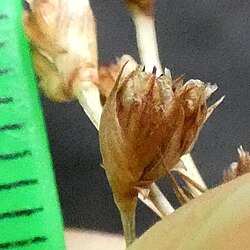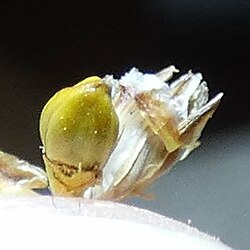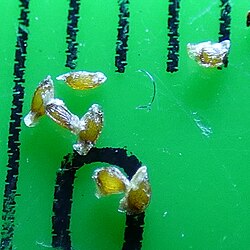Biology:Juncus heldreichianus
| Juncus heldreichianus | |
|---|---|
| Scientific classification | |
| Kingdom: | Plantae |
| Clade: | Tracheophytes |
| Clade: | Angiosperms |
| Clade: | Monocots |
| Clade: | Commelinids |
| Order: | Poales |
| Family: | Juncaceae |
| Genus: | Juncus |
| Species: | J. heldreichianus
|
| Binomial name | |
| Juncus heldreichianus T.Marsson ex Parl.[1]
| |
Juncus heldreichianus is a large tufted species of rush in the family Juncaceae, formed of two subspecies.
Description
A large, densely-stemmed rush, forming individualised (poorly-creeping) plants; ssp heldreichianus attains 100–150 cm with rather arching stems, ssp orientalis reaches 70 cm.
Inflorescences for ssp. heldreichianus are usually long and narrow, appearing stretched-out, with well-spaced lax floral heads (therefore resembling J. maritimus, which however usually forms creeping patches), whilst for ssp. orientalis the inflorescence is composed of a closer spray of well-separated heads of flowers.
The individual flowers have 6 tepals typical of the genus Juncus, but with the inner 3 with broad pale margins, notched at the top, the flowers having an over all light brown colour (J. littoralis being dark brown).
The mature fruit capsules are up to 4 mm (J. acutus 4–6 mm) with blunt seams converging as a blunt tip (J. littoralis having sharp seams converging to a sharp pyramidal tip).
Seeds are small (0.8-0.9 mm long, 1.0-1.5 mm with appendages) compared to J. littoralis (0.8-1.1 mm long, 1.5-2.0 with appendages).[2][3]
Range
Species - Albania, Cyprus, East Aegean Is., Greece, Iran, Kriti, Lebanon-Syria, Tadzhikistan, Transcaucasus, Turkey, Turkey-in-Europe, Turkmenistan.[1]
subsp. heldreichianus - Albania, Cyprus, East Aegean Is., Greece, Kriti, Turkey, Turkey-in-Europe.[4]
subsp. orientalis - Iran, Lebanon-Syria, Tadzhikistan, Transcaucasus, Turkey, Turkmenistan.[5]
Habitat
ssp heldreichianus - Sand dunes, sandy places, salt and freshwater marshes, along streams, from sea level to 1700 m.[2]
ssp orientalis - Permanently or seasonally wet places, slightly to strongly saline habitats, known from sites between 800 and 1700 m.[2]
References
- ↑ 1.0 1.1 Plants of the World Online (with map) (species)
- ↑ 2.0 2.1 2.2 Species Plantarum / Flora of the World / Part 7. Juncaceae 2: Juncus subg. Juncus, 2002, compiled by Jan Kirschner
- ↑ Davis. Flora of Turkey and the East Aegean Islands, vol. 9.
- ↑ Plants of the World Online (with map) (ssp. heldreichianus)
- ↑ Plants of the World Online (with map) (ssp. orientalis)
Wikidata ☰ Q15506207 entry
 |









